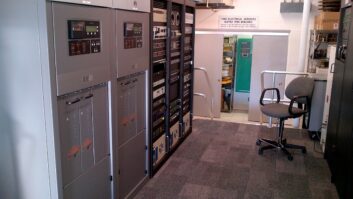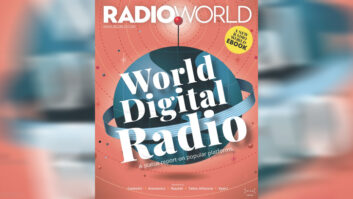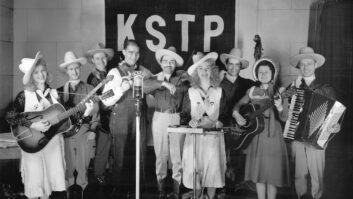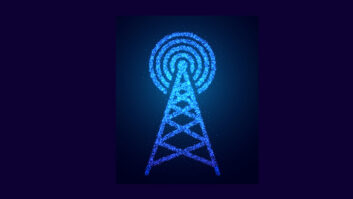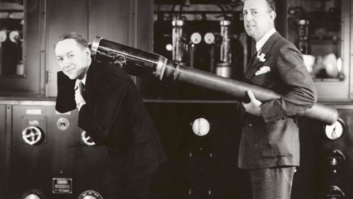
Christopher Springmann speaks into a CAD E100S with Pro Tools in the background. Radio World polled several of our contributors who have production duties on their résumés, asking about some of their favorite tools and practices. Participating were Al Peterson, assistant chief engineer for Radio America; Dave Plotkin, director of production and creative services, 1010 WINS(AM) in New York; Christopher Springmann, founder, producer, engineer of “Life Love & Health”; Tom Vernon, long-time radio veteran; and Curt Yengst, CSRE, assistant engineer at WAWZ(FM), Star 99.1, in Zarephath, N.J.
What’s your favorite mic?
Al Peterson: The Earthworks SR line has been a favorite of mine for awhile now. I’ve never been a fan of mics with an exaggerated bottom end. They sound great in headphones and give the male voice that rumbling power we all like to believe we have, but in the end I like the flat response with clarity at the top. I bought an SR mic right off the floor at an AES show some years back and I’m still using it. Ruler-flat out to about 30 kHz, and if I want to dial in extra thump or more shimmer, I can do that in software.
Dave Plotkin: My all-time favorite mic is the RCA 77B. The combination of the warm sound of the ribbon and the Art Deco look puts it at the top of my list. Needless to say it’s fantastic for recording live music. The Shure SM5B would fall second in line followed by a more practical and affordable preference, the Shure SM7B.
Christopher Springmann: Neumann BCM104 and the CAD E100S for broadcast; Sennheiser MKH60 for “urgent,” in-your-face L.A.-sound V/O. Sennheiser MD46 mics for location work.
Curt Yengst: For radio, I like the EV RE series. They’re built like tanks and sound good. For studio work, I sometimes miss my AKG C414. It’s a Swiss Army knife of a microphone. My current favorite is the Rode NT-2. I also love my Gyraf G7 tube mic that I built from a set of plans. Beast of a thing, but sounds great for vocals.
Do you have a favorite mixer?
Springmann: I like the Allen & Heath XB-14, for the built-in telco channels and mix-minus among other cool features. I have two Edirol R-44 four-track recorders with mixer functions, which we always use for backup recordings and occasional location work.
Yengst: I’m sort of partial to the old Tascam DM-24 digital mixer, probably because I own one and know my way around it. At Star 99.1 we use Yamaha 01V96s for production, and we’ve been very happy with them. Our main consoles are Wheatstone Audioarts D-75s. I love them because they can handle both digital and analog sources, and are easy to set up.
Plotkin: Well, if I had to pick a favorite console I would choose a former industry standard PR&E BMX-III. I have two myself. Although, there really is very little need to have a mixing console anymore when doing production. Everything can be mixed in the software. It’s amazing how far we’ve come.
How about favorite software platform? Plug-in(s)?
Yengst: While we use Adobe Audition at Star 99.1, my favorite audio platform is SAWStudio. I like it because it’s got the feel of a good old-fashioned analog console and multitrack. Plus it’s got the best-sounding summing buss I’ve ever heard. I use it primarily for recording and mixing music projects. For radio work I sometimes use the audio features in Sony Vegas. As far as plug-ins go, I actually tend not to use many. SAWStudio and Vegas already come with the basics, and I augment them with a few of the freebies I’ve featured in my recent “Free Software” articles for Radio World.
Plotkin: I am a fan of Adobe Audition. It’s designed for the radio production and creative director. It can be as powerful or simplistic as you make it. It’s an easy program to learn for the entry-level producer and sophisticated enough for the seasoned pro to be satisfied. I prefer the Waves Gold Bundle with Renaissance plug-ins to add to Audition
Peterson: I don’t have a favorite per se. I work primarily under Windows but have dabbled in Linux audio software for several years. I was a beta tester for Cool Edit back when it was a Syntrillium product and still enjoy using it. I teach college-level classes in Adobe Audition. At home I’m using Mixbus by Harrison (with the Ardour-based audio engine) and I have Audacity loaded on everything.
In between, I’ve used them all: SAWStudio, Vegas, the DSE-7000 and Audicy, the Roland DM-80 … It’s a long list.
I really should be better friends with Pro Tools. The product is everywhere you can think of, but I’ve just never been able to cozy up to it. It’s a great suite, but it’s expensive and not compatible with VST or LADSPA plug-ins, which I use a lot.
What’s your favorite tool or widget?
Springmann: Radio Systems CT-2002 studio timers. We have three, and live and die by them. I’m also quite partial to the Telos Hx2 hybrid, a brilliant, feature-rich, sophisticated instrument and moneymaker, especially now that we no longer use ISDN.
Plotkin: A classic — the Symetrix 528E mic processor. I love the challenge of getting it to sound just right.
Tom Vernon: My favorite tool with my MacBook Air laptop is the Digigram 442 Cancun USB Interface. With it, I can mix four microphones, and I get a robust headphone output. With a full charge on the laptop and the Cancun plugged into USB, running Audacity, you’re good for about one-and-a-half hours.
Yengst: My Swiss Army knife with the LED flashlight and 8 GB memory stick built in. I never leave home without it.
Peterson: My soldering gun. Nothing gets done until the cables work.
Are you all-digital?
Plotkin: That’s an interesting question. I am the guy people come to when they need a cart, record or reel transferred. However, all editing and producing is done in software. We do operate on a Harris VistaMax Digital network. Digital and analog both have their advantages. There is nothing like that “analog sound.”
Yengst: At Star, most of the inputs to the console are digital, including the mic processor outputs, AudioVault outputs and CD players. I think just the phones and traffic ISDN come in analog. From there it’s a completely digital signal path to the transmitter. We don’t use an IP network for audio. It’s all AES/EBU.
Peterson: At work, yes. At home, no — I’m analog right up to the Mixbus computer.
You are old enough to have survived the transition from analog to digital; what do you miss most about analog? How has digital made your life easier? Harder?
Peterson: There was a definite tactile satisfaction to doing a mix by ear with real faders under your fingertips. Certainly if you botched a move on a non-automated mixer, you would have to go back and do it again. And the next day, with fresh ears, you would hate the mix you did the day before. But all in all, I think that’s what I miss most.
I don’t miss recording to tape. Alignments, calibrations, head relapping, tensioning, degaussing, oxide shedding … you can keep all that. I’m pleased to find out, during a tape demonstration to my class, that I can still edit out a popped “p” at 15 ips with a razor blade. But sorry to say these days, that’s like boasting that you can still change the wick on a whale oil lantern.
Life is easier in that editing and timing extended segments can be fast and precise (I do long-form talk programming), and time-stretching means everything ends right on the tick.
On the other hand, life gets harder in that product obsolescence is not determined by you anymore. Operating systems reach end of life and you are obligated to shift everything upwards (ever try to run Cool Edit under Windows 8?). New versions of software may not be backwards-compatible with older versions, much less that $2,500 sound card you bought only four years ago. And with products like the Adobe suite moving up to “the cloud,” you don’t really even own your own editing equipment anymore.
Back in analog days, you could still find a rubber pinch roller for an Ampex reel machine built more than two decades prior. Even today, The Cart Guys out in Tucson sell kits to keep Fidelipac and Dynamax cart machines running. But if you called Studer tomorrow to say your Dyaxis digital editor needed parts, I don’t know what they would say at the other end.
Plotkin: When I started in radio, most everything was analog. I miss the “hands-on feel.” Splicing tape, cueing records and carting up spots. It may sound silly, but when dubbing a commercial onto cart, I miss the challenge of starting the cart machine a millisecond before pressing play on the reel. While splicing tape was an art unto itself, you can do so much more digitally. I would be at work until 2 a.m. every night if we still had to produce everything on tape. Digital editing has made it much easier to create more intricate audio pieces. However, I wouldn’t trade my analog education for anything. It’s what gave me the basis for being an excellent editor and trained me how to use my ears … not just look at a waveform.
Vernon: I remember the transition to digital very well. What I miss the most about analog is the unique “sound” that the equipment had, particularly vacuum tubes. There was an art and science to tuning up analog tape recorders, and when you got it right, not only were the specs on the money, but that unique sound was there as well.
Digital makes things easier, however, because it is ready to go the moment you turn the power on. No warming up equipment, no last-minute tweaks or adjustments. It either works or it doesn’t.
Yengst: As far as the transition from analog to digital goes, I think we’ve handled it well. What I like about it is that it takes less cable to move the same amount of channels, some of the gain-staging headaches are gone, and when handled properly, it does sound cleaner. What I miss about analog is that it was more forgiving. If something got overdriven, it just clipped and got a little crunchy sounding. You also didn’t have to worry about clocking signals, sample rates, and jitter. You just ran some cable and made it happen.
Springmann: A little background and context. I sort of came late to pro audio. I started “Life, Love & Health” in 2003, after spending 25 years in the advertising, annual report and magazine photography business, just as digital was overwhelming and replacing film. Fortunately, the same thing was happening in audio capture, editing, production and distribution. My first recorder was an HHB MDP 500 MiniDisc recorder, quickly replaced by two Marantz PMD660s, which were replaced by the Roland R-44. Thus, I missed tape entirely.
I don’t miss anything about analog. Nothing. I am not sentimental about old inefficient technologies like typewriters, film and photo labs, plus endless driving; or tape recorders. All of these technologies had their day, era or centuries, some much longer than others, like film.
Digital has made life so much easier, efficient and fun. The “Lifesaver Factor”: the ability to instantly review, then make a duplicate of a WAV file and archive it, and/or move it to an FTP site or remote server, way beyond the original recorder, the world’s cheapest career insurance.
Nonlinear, nondestructive editing, never physically “touching” (literally) the original, is a joy.
Do you do more or less in-house production than you did in the past?
Plotkin: We do an enormous amount of in-house production and imaging. We have fun creating agency-quality spots for our clients and constantly challenge ourselves with new station imaging and creative ideas.
Yengst: We’re doing way more in-house production at Star 99.1 than we’ve ever done. When I started there as a board operator back in the late ’80s/early ’90s, we had one production room. Now we have four production suites, which are always busy, and a couple people have limited production capabilities at their desks. I even have SAWStudio installed on my laptop in my office, in case I want to get into the act.
Springmann: Virtually everything is done in-house except for projects that require a collaborative team approach and a higher level of outside skills, especially video productions.
What topics would you like to see us cover more in Radio World? Write to radioworld@nbmedia.com.
